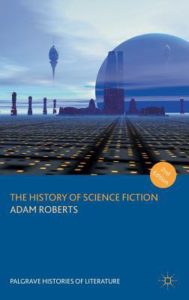 I found the early parts of this comprehensive history of sci-fi fascinating because the author starts his survey with the Ancient Greeks, 500 BCE. How could there be sci-fi before there was science, which took shape around 1500?
I found the early parts of this comprehensive history of sci-fi fascinating because the author starts his survey with the Ancient Greeks, 500 BCE. How could there be sci-fi before there was science, which took shape around 1500?
A loose interpretation of “science” fits the author’s main thesis, that the literature of the field can be roughly divided into fantastical stories that emphasize technology and materialism, or magic and spiritualism. The whole genre of sci-fi has always been a struggle between these antipodes. That’s the thesis on offer.
In that context, Homer’s Odyssey is sci-fi. It mainly concerns the material and technical universe. It is a work of fantasy, one must admit, with its cyclopean monsters, deadly Sirens and intervening gods. And it is about a real man on a real journey in a real boat. When Odysseus is trapped on Circe’s island, for example, and she offers him youthful immortality if he will stay, he refuses. He’d rather grow old and die with his wife and son, he says. According to the author, this is an affirmation of realism over magic.
So that’s how you get sci-fi before science had been invented. But even with this idiosyncratic definition of science, some examples of early sci-fi are startling. I would have said that the genre arose out of mid-1950’s anxiety about the bomb, aviation and rocketry, and Sputnik. But that is not so.
The first humanoid robot (basically, an android) appeared in literature in 1632 in a French novel by Charles Sorel, “Gazettes and News from Faraway Countries,” which featured a metallic, artificial woman with knowledge of all the world’s languages.
The terrain becomes more familiar as we move past the scientific revolution. Mary Shelly’s “Frankenstein” (1818), for example, is a clear-cut case of modern sci-fi, with an artificially constructed monster who goes rogue. The novel affirms and worries about technological change.
The conceptual split between materialism and magic was heightened during the Reformation, the author argues, when Luther staged his protest in 1517. After that, and even today, sci-fi can be identified as “Catholic” (magical) or “Protestant” (realist). The author urges caution. It’s not that some novels are Catholic and others are Protestant. Those are just handy indexes for the basic divide between materialism and magic.
So what are examples of “magical” sci-fi? A few titles stand out because of their mystical themes, such as Heinlein’s “Stranger in a Strange Land.” The Tolkein novels are readily viewed as allegorical spiritual messages and clearly so are many works of C.S. Lewis.
Material vs. magic is an interesting rubric for dissecting the genre but sometimes if feels a little forced or glib, but I have to admit it is handy, especially in surveying 20th century fiction where the volume becomes enormous.
Numerous examples of what I would call psi-fi, psychological fiction, are represented in the history, most of them with utopian and feminist themes, but not all. Frankenstein is basically psi-fi, the story of the monster’s quest for companionship and respectability. In a similar way, “The Sandman” (1816), by German writer Ernst Hoffmann, concerns a poet who falls in love with a beautiful woman who turns out to be an automaton constructed by an evil scientist. It raises and answers the question of whether a human could fall in love with a machine. Later, psi-fi runs rampant in the literature (Asimov’s I, Robot, Clarke’s Childhood’s End, Silverberg’s Dying Inside, others).
Where does psi-fi fall on the dichotomy of magical vs materialist? It doesn’t. Psi-fi is about psychology, the human mind, which is intangible, not material (i.e., it is not the brain. Ideas have no mass). And yet psi-fi is not about “magic” either. The mind is completely natural. Psi-fi is a kind of realism however, affirming the reality of our technological world, so I guess it’s closer to the “Protestant” end of the spectrum, although its poor fit into that dichotomy illustrates that Roberts’s analytic rubric contains unexamined assumptions.
Oddly for a history, the index is only a name index, with no titles or concepts, limiting the book’s usefulness as a reference. Even so, browsing it is a good way to look for new reads in a very expansive and complex genre.
Roberts, Adams (2016). The History of Science Fiction, 2nd Edition. London: Palgrave/Macmillan (524 pp).